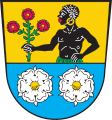Wolffskeel



The family of the Imperial Knights and Barons Wolfskeel , later Count Wolffskeel von Reichenberg , belonged to the Franconian nobility .
history
The documented line of the family of the Franconian nobility that still exists today began in 1219 with knight Otto I. von Wolfskeel, who was an episcopal castle man at the Marienberg fortress in Würzburg and mayor of the city of Würzburg.
The earlier origins of the family are uncertain. The earlier thesis that the Franconian Wolfskeels were descended from the Hessian lords of Wolfskehlen and immigrated from there to Franconia is largely rejected today. Biedermann describes an Eberhard Wolfskeel as the progenitor of the Franconian Wolfskeels, who is said to have lived as early as 930.
The same origin as the Wolfskeel dynasty are the Lords of Grumbach , who today are mainly represented as an independent family, but were a line of the Wolfskeel family that developed when a part of the Wolfskeel family resident in Burggrumbach initially became "Wolfskeel von Grumbach", later only called "von Grumbach"; Burggrumbach has belonged to a third since 1282 and completely to the Wolfskeel family since 1328.
In 1376 knight Eberhard von Wolfskeel came into possession of Reichenberg Castle near Würzburg ; since then the family has been called "Wolfskeel von Reichenberg" after their headquarters in Reichenberg
Until the middle of the 16th century, members of the Wolfskeel family were closely connected to the diocese of Würzburg and represented Wolfram Wolfskeel von Grumbach from 1322 to 1333 , Otto II von Wolfskeel from 1333 to 1345 and Johann III from 1455 to 1466 . von Grumbach three prince-bishops of Würzburg.
At the beginning of the early 16th century, however, a change took place and the Wolfskeel came more and more from the vicinity of the diocese of Wuerzburg out and bound more tightly to the Frankish kingdom of chivalry , where they first located the Knights Canton Steigerwald and down in 1492 but the Knights Canton Odenwald zurechneten .
The Wolfskeel family adopted the Evangelical - Lutheran denomination in the middle of the 16th century and, with the exception of the Rottenbaurer line, which later became extinct, has kept it up to the present day. The Wolfskeels dynasty founded numerous Protestant enclaves in the Catholic diocese of Würzburg.
Due to the related resignation from most offices of the Diocese of Würzburg, the Wolfskeels started careers at foreign royal courts such as Austria , Brandenburg-Ansbach , Württemberg , Saxony-Weimar , Hesse and Wolfenbüttel , where they also reached the highest offices.
With mediatization, the family lost its imperial immediacy. In 1819 the gender was registered in the baron class in the Kingdom of Bavaria. In 1901 Karl Freiherr Wolfskeel von Reichenberg was raised to the status of hereditary count by Prince Regent Luitpold of Bavaria . The increased rank was now indicated with a second "f", ie "Wolffskeel" instead of "Wolfskeel". The baronial line of the family died out in the male line in 1927. The counts line based in Uettingen still exists today.
The so-called Wolffskeel'schen Ländle included Reichenberg, Albertshausen, Hattenhausen, Uengershausen, Lindflur , Rottenbauer , Fuchsstadt , Geroldshausen and Uettingen .
Selected personalities
- Wolfram Wolfskeel von Grumbach , Prince-Bishop of Würzburg from 1322 to 1333.
- Otto II von Wolfskeel , Prince-Bishop of Würzburg from 1333 to 1345.
- Julius Friedrich Freiherr Wolfskeel von Reichenberg (1628–1703), senior official and since 1695 as court councilor in the margraviate of Brandenburg-Ansbach, the highest-ranking court servant, supervised all administrative, police and judicial matters in the principality.
- Johann Christoph Freiherr Wolfskeel von Reichenberg, knight captain of the knight canton Odenwald (1686–1694).
- Johann Gottfried Ignaz Freiherr Wolfskeel von Reichenberg (1693–1779), Würzburg canon, court chamber and court war council president.
- Christiane Freiin Wolfskeel von Reichenberg, married von Katsch, Chief Chamberlain of Elisabeth Christine von Braunschweig-Wolfenbüttel-Bevern .
- Christian Freiherr Wolfskeel von Reichenberg (1761–1809), Imperial Austrian Lieutenant Field Marshal , holder of the Military Maria Theresa Order .
- Philipp Sigmund Freiherr Wolfskeel von Reichenberg (1762–1828), Imperial Austrian Major, holder of the Military Maria Theresa Order.
- Christian Friedrich Carl Freiherr Wolfskeel von Reichenberg : Honorary title of excellence , real councilor , general superintendent , from 1807 Chancellor of the Duchy or Grand Duchy of Saxony-Weimar-Eisenach .
- Henriette Freiin Wolfskeel von Reichenberg (1776-1859), married Baroness von Fritsch, lady-in-waiting of Duchess Anna Amalia of Saxe-Weimar-Eisenach , confidante of Goethe .
- Johann Karl Freiherr Wolfskeel von Reichenberg, first lieutenant, member of the Bavarian state parliament (1855–1857).
- Baroness Karoline Wolfskeel von Reichenberg made the Uettingen Castle, which she inhabited, available as a hospital during the German War in 1866 and sacrificed herself to care for the wounded, was awarded the Theresa Order and when King Ludwig II of Bavaria visited Uettingen Castle awarded the Order of Merit of the Bavarian Crown .
- Karl Graf Wolffskeel von Reichenberg (1847–1919), royal Bavarian colonel stable master , Oberstjägermeister, lieutenant general à la suite , curator of King Otto of Bavaria , close friend and advisor to Prince Regent Luitpolds of Bavaria , founder of the line of the counts.
- Eberhard Graf Wolffskeel von Reichenberg (1875–1954), German officer, involved in the genocide of the Armenians .
- Luitpold Graf Wolffskeel von Reichenberg (1879–1964), German officer, first commander of the Bavarian Air Force, aviation pioneer.
coat of arms
Family coat of arms
The family coat of arms shows a Moor walking to the right with three red roses in his right hand. On the helmet with black and gold helmet covers over a silver (gold) hooded hat, a flight from black to silver is divided diagonally to the right . Some depictions also show a flag split in black and gold, topped with a golden orb.
The coat of arms first appeared on the tomb of the Würzburg prince-bishop Wolfram Wolfskeel von Grumbach (1322-1333). The original origin or meaning of the coat of arms is not known for sure. A reference to Saint Mauritius is most likely , with the three red roses symbolizing the Trinity of God.
The Grumbacher line of the Wolfskeel family initially carried the same coat of arms, which is why the Wolfskeel'sche Mohr is also based on that of Johann III. Franconian ducal sword commissioned by Grumbach is located. When the Wolfskeel von Reichenberg divided more and more with their line from Grumbach in the 14th and 15th centuries and demanded a separation of the coat of arms from the unpopular relatives, the Roman-German King Maximilian I decided in 1492 that the Mohr should follow the Wolfskeels coat of arms right, in the coat of arms of the Grumbachs walks to the left.
In the coat of arms of 1901 on the occasion of the elevation of Baron Karl Wolfskeel von Reichenberg to hereditary count, the count's coat of arms is described as follows: “In gold, a half-right turned, striding, naked, black moor with black plumage, in his right hand three gold-inseminated red roses on green Holding styles. On the shield rests a gold tournament helmet with black and gold covers, which wears a black tournament hat turned over with hermaphrodites; the latter is covered with a closed flight of eagles, diagonally divided by black and silver, and between the same with an inclined, black-and-gold-divided and with a gold orb topped two-pronged tournament flag with a gold shaft and silver lance tip. Shield holders are two outwardly turned naked, black moors with black feather hip aprons and golden forehead braces, each holding a golden lance with a silver tip and a red tassel. The whole coat of arms is surrounded by a hermel-lined purple coat of arms, which is held together at the top by a nine-pearl count's crown. "
Coat of arms of the Wolfskeel family according to Siebmacher's book of arms
Coat of arms of the Wolfskeel family based on Scheibler's book of arms , atypical representation
Coat of arms of the barons Wolfskeel according to Tyroff's book of arms of the Austrian monarchy
County and municipal coats of arms
The coat of arms of the Wolfskeel and Grumbach has found its way into various municipal coats of arms and was also part of the coat of arms of the Würzburg district until 1974.
Honors
The Wolfskeel'sche Mohr was included in the old coat of arms of the Würzburg district due to the importance of the family. The Wolffskeel Realschule, founded in Würzburg in 1967, got its name because the family left lasting traces in both the district and the city of Würzburg. The "Wolfskeel Room" at Marienberg Fortress and the Wolffskeel Hall in Reichenberg is named after the family. In addition, several streets and squares are named after the Wolffskeel family.
literature
- Constantin von Wurzbach : Wolfskeel zu Reichenberg, the barons, genealogy . In: Biographisches Lexikon des Kaiserthums Oesterreich . 58th part. Imperial-Royal Court and State Printing Office, Vienna 1889, p. 42 f. ( Digitized version ).
- Genealogical handbook of the nobility enrolled in Bavaria, Volume XXIX (2012)
- Ulrich Rüthel: The History of Count Wolffskeel von Reichenberg zu Uettingen (2002)











